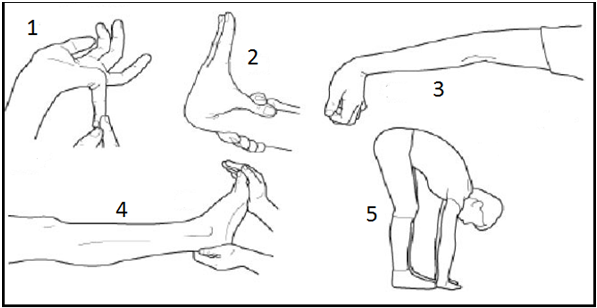Brighton criteria for the diagnosis of BJHS.

Left Elbow Extension
Journal of Chiropractic Medicine
Major Criteria
• Beighton score of ≥ 4 (Fig. 2)
• Arthralgia for longer than 3 months in 4 or more joints
Minor Criteria
• Beighton score of 1, 2, or 3 (Fig. 2)
• Arthralgia (> 3-month duration) in 1-3 joints or back pain (> 3-month duration) or spondylosis, spndylolysis/spondylolisthesis.
• Dislocation or subluxation in more than one joint, or in one joint on more than one occasion.
• Three or more soft tissue lesions (eg, epicondylitis, tenosynovitis, bursitis)
• Marfanoid habitus (tall, slim, span greater than height [> 1.03 ratio], upper segment less than lower segment (< 0.89 ratio), arachnodactyly)
• Skin striae, hyperextensibility, thin skin, or abnormal scarring
• Ocular signs: drooping eyelids, myopia, antimongoloid slant
• Varicose veins, hernia, or uterine or rectal prolapse, mitral valve prolapse
Requirement for diagnosis
BJHS is diagnosed in the presence of 2 major criteria, one major criterion plus 2 minor criteria, or 4 minor criteria. Two minor criteria will suffice where there is an unequivocally affected first-degree relative in family history. The syndrome is excluded by the presence of Marfan or Ehlers-Danlos syndrome (other than the hypermobility type of Ehlers-Danlos syndrome, formerly EDS III).

Right Elbow Extension
Journal of Chiropractic Medicine
Fig 2..
Nine-point Beighton score for joint hypermobility.
Passive dorsiflexion of the fifth metacarpophalangeal joint to at least 90°.
(1 point for left; 1 point for right)
Passive opposition of the thumb to the volar aspect of the ipsilateral forearm
(1 point for left; 1 point for right)
Active hyperextension of the elbow to at least 10°
(1 point for left; 1 point for right)
Active hyperextension of the knee to at least 10°
(1 point for left; 1 point for right)
Lumbopelvic forward flexion with placement of hands flat on the floor without bending the knees (1 point)
One point is gained for each side of the body for the first four maneuvers listed above, such that the hypermobility score is a maximum of 9 if all are positive.

Right Knee Extension
Journal of Chiropractic Medicine

Image from Physiopedia

Right Thumb Hypermobility
Journal of Chiropractic Medicine

Left Thumb Hypermobility
Journal of Chiropractic Medicine

Trunk Flexion Hypermobility With Hands Flat on the Floor
Journal of Chiropractic Medicine